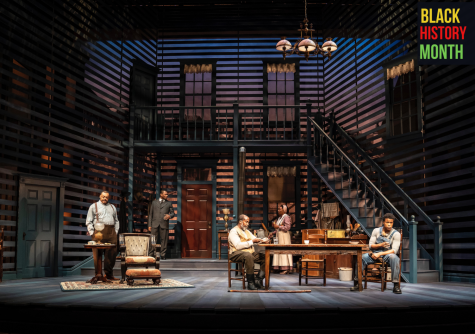Review: ‘Gem of the Ocean’ is a complex story about complicated issues of life after slavery
February 28, 2022

A man is cleaning up his rifle without saying a word, and the only sound heard by the audience is the unsettling and anxiety-provoking noise in the background that accentuates the uncertainty of the scene.
“Gem of the Ocean” is a drama, written by August Wilson and set in Pittsburgh in 1904, 39 years after slavery was abolished. The play first premiered at the Goodman Theatre, 170 N. Dearborn St., in 2003 and made its resurgence this year, 19 years later. The show opened on Jan. 22 and ran through Feb. 27.
The play is the first part of Wilson’s decade-by-decade 10-play chronicle — dubbed the Century or Pittsburg Cycle — exploring themes of self-identity, freedom and the African American experience.
The entire play is set in one location, the house of 285-year-old Ester Tyler who is a soul cleanser and was formerly enslaved. Aunt Ester lives with Black Mary, her protege housekeeper, and her spiritual guard Eli, with visits from her suitor Solly Two Kings, who also used to be enslaved and helps others escape by working on the Underground Railroad with Eli.
The play explores the struggles of each resident in Aunt Ester’s house, including Citizen Barlow, who has sought out Aunt Ester to have his soul cleaned.
Citizen Barlow has moved away from his home state of Alabama to find a better life but instead gets exploited at the mill where he works and ends up in debt. Barlow steals a bucket of nails and runs off. Another man named Garret Brown gets blamed for the theft and drowns in the river after resisting arrest by Caeser, the town sheriff and Black Mary’s brother.
The play has a little bit of everything starting with a romance between characters Aunt Ester and Solly Two Kings, who is a known womanizer but promises to leave it behind by marrying her. Additionally, Black Mary has feelings for Citizen Barlow, wanting a man to make her feel something, but Citizen Barlow has nothing to offer her but himself.
The play has a good share of humor, evoking chuckles and laughter from the audience. There is a spiritual musical backdrop with singing and clapping that denotes a range of emotion from joy to deep sadness.
The play is dialogue-heavy, which requires the viewer’s undivided attention. Being distracted even for a second can make you lost in the dialogue between characters.
I enjoyed the complex dynamic between Aunt Ester, played by Lisa Gaye Dixon, and Black Mary, played by Sydney Charles. Aunt Ester constantly nags Black Mary that the way she is doing chores around the house is wrong and when Mary finally talks back Ester answers, “Took you long enough.”
Even though Aunt Ester and Black Mary get on each other’s nerves, Aunt Ester sees in Black Mary an heiress of her knowledge and spirituality. Dixon and Charles have enormous charisma and stage presence, bringing their characters to life.
Toward the middle of the play, it becomes harder to keep attention on long monologues and dialogues, but at the end, the play truly shines. The last scene brings the audience members to their feet after letting themselves get attached to the characters, sharing the the release of anxious pressure that built up throughout the play.
“Gem of the Ocean” captures the essence of the start of the 20th century and truly feels like a time machine.







